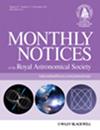存在大质量中微子时各种宇宙环境中的单点统计
IF 4.8
3区 物理与天体物理
Q1 ASTRONOMY & ASTROPHYSICS
引用次数: 0
摘要
研究结构(光环和星系)所在的宇宙环境(虚空、片状、丝状和节点)中的结构是宇宙学研究中的一项持续性尝试。结构的特性与宇宙环境之间的联系可能有助于揭示宇宙暗部的本质。在本文中,我们从空间模式的角度,以ΛCDM和νΛCDM作为香草模型的扩展为例,研究了宇宙网络环境。为此,我们使用T-web分类法,对来自ΛCDM和νΛCDM宇宙学Gevolution N-body模拟目录的宇宙环境进行分类。然后,我们计算每个宇宙环境的第一近邻累积分布函数、球面接触累积分布函数和 J 函数。在标准模型的背景下,结果表明这些函数可以区分不同的宇宙环境。在区分宇宙标准模型的扩展方面,宇宙环境中的这些函数似乎是有益的补充探测器。本文章由计算机程序翻译,如有差异,请以英文原文为准。
One-point statistics in various cosmic environments in the presence of massive neutrinos
Studying the structures (halos and galaxies) within the cosmic environments (void, sheet, filament, and node) where they reside is an ongoing attempt in cosmological studies. The link between the properties of structures and the cosmic environments may help to unravel the nature of the dark sector of the Universe. In this paper, we study the cosmic web environments from the spatial pattern perspective in the context of ΛCDM and νΛCDM as an example of an extension to the vanilla model. To do this, we use the T-web classification method and classify the cosmic environments for the catalogues from the gevolution N-body simulations for ΛCDM and νΛCDM cosmology. Then, we compute the first nearest neighbour cumulative distribution function, spherical contact cumulative distribution function, and J-function for every cosmic environment. In the context of the standard model, the results indicate that these functions can differentiate the various cosmic environments. In association with distinguishing between extensions of the standard model of cosmologies, these functions within the cosmic environment seem beneficial as a complementary probe.
求助全文
通过发布文献求助,成功后即可免费获取论文全文。
去求助
来源期刊

Monthly Notices of the Royal Astronomical Society
ASTRONOMY & ASTROPHYSICS-
CiteScore
9.10
自引率
37.50%
发文量
3198
审稿时长
3 months
期刊介绍:
Monthly Notices of the Royal Astronomical Society is one of the world''s leading primary research journals in astronomy and astrophysics, as well as one of the longest established. It publishes the results of original research in positional and dynamical astronomy, astrophysics, radio astronomy, cosmology, space research and the design of astronomical instruments.
 求助内容:
求助内容: 应助结果提醒方式:
应助结果提醒方式:


